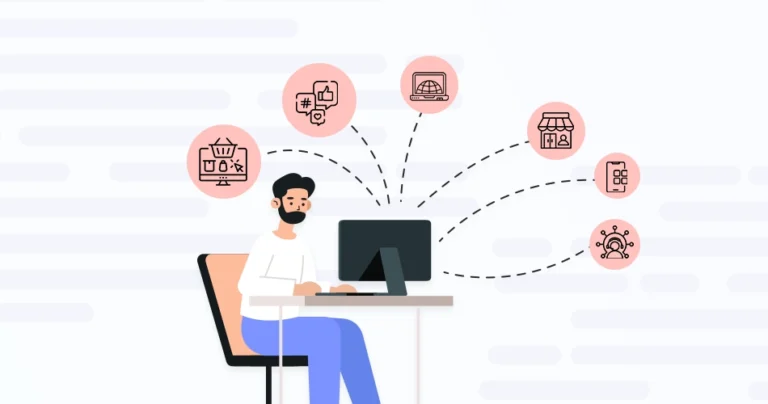Beyond the features, one of the most significant aspects of any eCommerce business or website is the shopping experience. To that end, a multichannel eCommerce strategy can be a game-changer. It can help increase their visibility, reach a wider audience, and boost sales.
Showcasing your offerings on multiple channels can help you tap into diverse customer segments and increase your overall market share. But implementing multichannel eCommerce requires careful planning and execution.
In this blog, you’ll learn how the professional eCommerce services go about executing the multichannel strategy and what benefits it offers. Let’s begin.
What is Multichannel eCommerce?
Multichannel eCommerce is a sales strategy where a business sells its products or services through multiple online channels. This includes the company’s own website, marketplaces like Amazon and eBay, social media platforms, and mobile apps.
Instead of relying solely on a single platform, businesses can expand their reach by meeting customers where they prefer to shop.
By adopting a multichannel approach, businesses can increase their visibility, target different customer segments, and ultimately boost sales. It’s about providing customers with convenience and choice, while also diversifying your revenue streams.
However, managing multiple channels can be complex. It requires careful planning and efficient management to ensure a consistent customer experience.
How is Multichannel eCommerce Different from Omnichannel eCommerce?
While both multichannel and omnichannel eCommerce involve selling products through multiple channels, there’s a crucial difference in their focus.
Multichannel eCommerce is primarily focused on channels. It’s about selling on different platforms like your website, marketplaces, and social media. While it offers a wider reach, each channel operates independently. There’s less emphasis on a unified customer experience.
Omnichannel eCommerce is centered around the customer. It’s about creating a seamless and integrated shopping experience across all channels. This means a customer can start a purchase on your website, continue it on your mobile app, and complete it in-store. Data is shared between channels to provide a personalized experience.
Essentially, omnichannel is a more advanced version of multi channel eCommerce. It requires a higher level of integration and coordination between different channels to deliver a cohesive customer journey.
Benefits of Multichannel eCommerce
Multichannel eCommerce offers several advantages for businesses looking to expand their reach and increase sales:
- Increased Reach: Selling on multiple platforms exposes your products to a wider audience, allowing you to tap into new customer segments.
- Boosted Sales: By being present on various channels, you increase the chances of converting site visitors into paying customers.
- Enhanced Brand Visibility: Multiple touchpoints with customers can strengthen brand awareness and recognition.
- Data-driven Insights: Selling across different channels provides valuable data on customer behavior, preferences, and trends.
- Mitigated Risk: Diversifying sales channels can help protect your business from relying solely on one platform.
- Improved Customer Experience: Offering multiple shopping options caters to different customer preferences, enhancing overall satisfaction.
- Competitive Advantage: Being present on multiple channels can help you stay ahead of competitors and gain a market edge.
By leveraging the benefits of multichannel eCommerce, businesses can achieve significant growth and success. To make the best of this strategy, you can consult with our eCommerce development services.
How to Implement Multichannel eCommerce?
Multichannel eCommerce is quite an advantageous strategy, but that would require following a strategic process.
Select the Right Channels
The foundation of a successful multichannel strategy lies in selecting the appropriate platforms. Consider your target audience, product type, brand image, and competitive landscape.
Analyze the strengths and weaknesses of various channels like your own website, marketplaces (Amazon, eBay), social media platforms (Instagram, Facebook), and mobile apps. Choose multiple sales channels that align with your business objectives and where your customers are most likely to engage.
Implement Inventory Management
Efficient inventory management is crucial for preventing stockouts and ensuring timely order fulfillment across multiple channels. A centralized system that provides real-time visibility into stock levels is essential.
Accurate data synchronization between different platforms is vital to avoid discrepancies and customer dissatisfaction.Consider using inventory management software to streamline operations and minimize errors.
Do Consistent Branding
A strong brand identity is essential for building customer loyalty and recognition. Ensure consistent branding across all channels, including logo, color scheme, tone of voice, and product imagery. This creates a cohesive customer experience and reinforces your brand message.
Work on Customer Experience
Delivering a seamless customer experience is paramount in multichannel selling. Implementing personalization and timely order updates contribute to a positive customer experience, encouraging repeat business. Also offer consistent customer support channels and ensure smooth order tracking and returns.
A positive customer experience fosters loyalty and drives repeat business.
Integrate the Right Technologies and Techniques
Technology plays a vital role in managing a multichannel sales operation. Invest in an eCommerce platform that supports integration with multiple channels. Utilize data analytics tools to gather insights into customer behavior and performance metrics. Implement an order management system to streamline order processing and fulfillment.
Implement the Best Marketing Strategies
Develop and implement the best eCommerce marketing campaigns for each channel to maximize reach and engagement. Utilize social media advertising, email marketing, and search engine optimization (SEO) to drive traffic to your channels. Track the performance of your multichannel marketing efforts to identify what works best and allocate resources accordingly.
Monitor and Optimize the Ecosystem
Regularly analyze sales and customer data, customer behavior, and channel performance to identify trends and areas for improvement. Use key eCommerce metrics to measure the success of your multichannel strategy. Be prepared to make adjustments to your approach based on data-driven insights.
Continuous optimization is essential for staying competitive and achieving long-term success.
If you need help with implementing the best multichannel strategy for your eStore, consult with our eCommerce development company.
Best Channels for Multichannel eCommerce
There are several channels to showcase your products and services. But some would help more than others. Let’s take a look.
Your Own Website
First off, create your eCommerce website; it will be the hub of all things. It offers unparalleled control over branding, customer experience, and data collection. However, an online store requires substantial investment in development (with an eCommerce software), maintenance, and digital marketing.
To maximize its potential, consider implementing robust SEO, personalization, and seamless integration with other channels.
Social Media Platform
Social media has transformed into a powerful sales channel. Its ability to directly engage with customers is unmatched. However, organic reach is increasingly challenging, necessitating paid advertising and creative content strategies.
Platforms like Instagram, Facebook, and TikTok offer distinct opportunities. For instance, Instagram’s visual focus is ideal for showcasing products. On the other hand, TikTok’s short-form video format can foster brand affinity.
Online Marketplaces
Multi-vendor marketplaces like Amazon, eBay, and Walmart provide immediate access to vast customer bases. They can accelerate sales growth but often come with hefty fees and competitive pressures. To succeed, optimize product listings, leverage customer reviews, and prioritize fast shipping.
Physical Store
While traditional brick-and-mortar stores might seem outdated, they remain essential for many businesses. They offer opportunities for direct customer interaction, building brand loyalty, and showcasing products tangibly.
Consider integrating online and offline experiences through features like in-store pickup, buy online, pick up in-store (BOPIS), and augmented reality (AR) try-ons.
Email Marketing
Email marketing remains a highly effective channel for nurturing customer relationships and driving conversions. It allows for personalized communication and targeted promotions. Building a robust email list and delivering valuable content are key to success.
Mobile Apps
Dedicated mobile apps can enhance customer engagement and loyalty. They offer personalized recommendations, push notifications, and seamless checkout experiences. However, developing and maintaining an app requires significant investment and technical expertise.
Selecting the optimal channel mix depends on various factors. That includes your target audience, product type, brand image, resources, and competitive landscape. Carefully consider these elements to create a multichannel strategy driving growth and customer satisfaction.
Wrapping Up Multichannel eCommerce!
Multichannel eCommerce involves selling across multiple platforms. You can significantly expand your reach, increase sales, and deepen customer relationships. However, implementing and managing a successful multichannel approach requires careful planning, execution, and continuous optimization.
Remember, the key to success lies in understanding your target audience and providing exceptional customer service. Plus, you need to harness the power of data analytics to refine your strategy.
So, want to build the best multichannel eCommerce strategy? Then talk to our experts today!
FAQs on Multichannel eCommerce
Q1. How do I choose the right channels for my business?
Consider your target audience, product type, competition, resources, and business goals. Popular options include your website, social media platforms, marketplaces, and mobile apps.
Q2. How do I manage inventory across multiple channels?
Implement a centralized inventory management system to track stock levels accurately. Use real-time updates to avoid stockouts and overselling.
Q3. What is the future of Multichannel eCommerce?
The future of multichannel eCommerce lies in personalization, integration with emerging technologies like AI and AR, and a focus on customer experience. Omnichannel will become increasingly important as customers expect seamless shopping journeys.





